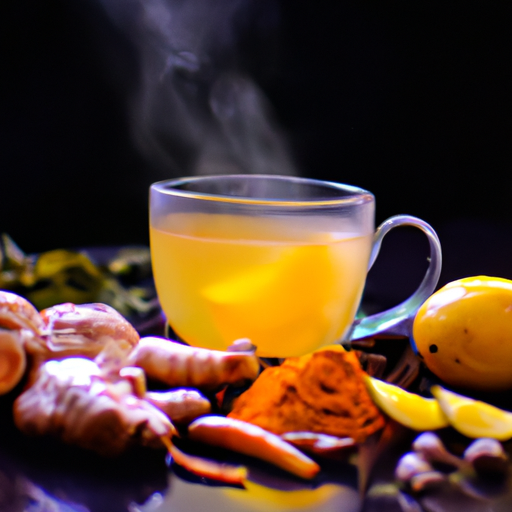Do you like to enjoy a warm cup of tea in the mornings or afternoons? Are you curious about the health benefits of turmeric and how you can add it to your tea? You’ll be pleased to know that you can incorporate turmeric into your daily tea routine!
Turmeric and tea can be a powerful combination when it comes to improving your overall health and well-being. Turmeric has been used for centuries in traditional medicine as a natural remedy for various ailments. It contains a compound called curcumin, which has anti-inflammatory and antioxidant properties.
Tea, on the other hand, is known for its high levels of antioxidants and its ability to improve brain function, reduce the risk of chronic diseases, and aid in weight loss. Combining these two powerful ingredients can create a potent drink that offers a multitude of benefits.
In this article, we will explore the science behind combining turmeric and tea, the potential risks, and the best ways to incorporate this combination into your daily routine.
Key Takeaways
- Combining turmeric and tea can have synergistic effects and boost the bioavailability of curcumin.
- Optimal dosage is crucial for getting the most out of this combination, and precautions should be taken to avoid potential risks and interactions.
- Turmeric and tea can provide a multitude of health benefits, including reducing inflammation, protecting against damage from harmful free radicals, improving digestion, and enhancing cognitive function.
- Other ways to incorporate turmeric into your diet include adding it to smoothies, soups, and curries, cooking with it, or taking it in supplement form.
The Benefits of Turmeric
You’ll be happy to know that adding turmeric to your tea can provide you with a multitude of health benefits. Turmeric, also known as the ‘golden spice,’ has been used for medicinal purposes for centuries.
The active compound in turmeric, curcumin, has been found to have anti-inflammatory and antioxidant properties. This means it can help reduce inflammation in the body and protect against damage from harmful free radicals.
Turmeric recipes are easy to incorporate into your daily routine. Simply add a teaspoon of turmeric powder to your tea and reap the benefits. Not only does it add a warm, earthy flavor to your drink, but it also provides an array of health benefits.
From improving brain function to aiding in digestion, turmeric has a lot to offer. And when combined with the benefits of tea, you have a powerful combination for promoting overall wellness.
The Benefits of Tea
Sipping on a warm cup of tea offers numerous health benefits, making it a popular beverage choice around the world. Tea varieties such as green, black, white, and herbal teas are rich in antioxidants, which help protect your body from damage caused by harmful free radicals.
Drinking tea regularly has been linked to improved digestion, reduced inflammation, and enhanced cognitive function. Brewing techniques can also play a role in the health benefits of tea. Steeping tea for the right amount of time can ensure that the maximum amount of antioxidants and other beneficial compounds are extracted from the tea leaves.
Additionally, adding lemon to your tea can increase the absorption of these compounds by your body. So go ahead and sip on your favorite tea, knowing that it’s not only delicious, but also good for your health. And don’t forget to stick around to learn about the science behind combining turmeric and tea!
The Science Behind Combining Turmeric and Tea
When it comes to boosting your health, did you know that combining turmeric and tea can have some impressive benefits? The science behind this combination is fascinating.
Turmeric contains a compound called curcumin, which has anti-inflammatory and antioxidant properties. However, the bioavailability of curcumin is low, meaning that your body has trouble absorbing it. Luckily, tea can help with this problem.
Tea contains compounds called catechins, which can boost the bioavailability of curcumin. Additionally, the combination of turmeric and tea can have synergistic effects, meaning that the two substances work together to have even more significant health benefits. However, it’s important to note that optimal dosage is crucial for getting the most out of this combination.
Too much turmeric or tea can have negative effects, so it’s essential to consult with a healthcare professional before adding this combination to your diet. As you can see, combining turmeric and tea can be incredibly beneficial for your health. However, it’s essential to know how to combine them correctly to get the most out of their benefits.
In the next section, we will discuss some ways to combine turmeric and tea to achieve optimal health benefits.
How to Combine Turmeric and Tea
To achieve optimal health benefits, it’s important to know how to combine turmeric and tea. There are numerous turmeric and tea recipes that you can easily make at home. One popular recipe is the Turmeric Ginger Tea, which combines turmeric, ginger, and black pepper with your favorite tea. Another recipe is the Golden Milk, which is a turmeric-based drink that can be enjoyed hot or cold. It combines turmeric, milk, honey, and various spices to create a healthy and delicious beverage.
Aside from the taste, combining turmeric and tea also offers a variety of health benefits. Turmeric contains a powerful anti-inflammatory compound called curcumin, which has been shown to reduce inflammation and pain in numerous studies. Tea, on the other hand, contains antioxidants that help fight off free radicals and prevent chronic diseases. By combining these two ingredients, you can create a drink that not only tastes good but also promotes overall health and wellness.
However, it’s important to note that combining turmeric and tea may have potential risks. Let’s discuss these risks in the next section.
Potential Risks of Combining Turmeric and Tea
Before combining turmeric and tea, it’s important to be aware of the potential risks.
Interactions with certain medications can occur, such as blood thinners, so it’s important to consult with your healthcare provider if you’re taking any medications.
Additionally, some people may experience allergic reactions to turmeric. It’s important to pay attention to any symptoms and seek medical attention if necessary.
Interactions with Medications
Did you know that turmeric may interact with certain medications? It’s important to talk to your healthcare provider before adding it to your tea. Here are some of the interactions and side effects that you should be aware of:
-
Turmeric may interact with blood thinners, such as warfarin, and increase the risk of bleeding. If you’re taking any blood thinners, it’s important to talk to your healthcare provider before consuming turmeric.
-
Turmeric may interact with medications that reduce stomach acid, such as antacids, and reduce their effectiveness. If you’re taking any medications for acid reflux or heartburn, it’s important to talk to your healthcare provider before consuming turmeric.
-
Turmeric may interact with medications that lower blood sugar levels, such as diabetes medications, and increase the risk of hypoglycemia. If you’re taking any medications for diabetes, it’s important to talk to your healthcare provider before consuming turmeric.
-
Turmeric may interact with medications that suppress the immune system, such as chemotherapy drugs, and reduce their effectiveness. If you’re undergoing chemotherapy or taking any medications that suppress the immune system, it’s important to talk to your healthcare provider before consuming turmeric.
It’s important to be aware of these interactions and side effects before adding turmeric to your tea.
In the next section, we’ll discuss the potential allergic reactions that may occur when consuming turmeric.
Allergic Reactions
If you’ve never experienced an allergic reaction, it’s important to be aware of the potential risks associated with adding turmeric to your daily routine. Turmeric is known to be a potent anti-inflammatory and antioxidant, but it can also cause allergic reactions in some people.
Symptoms of an allergic reaction to turmeric can range from mild to severe, and can include hives, swelling, itching, and difficulty breathing. In some cases, an allergic reaction to turmeric can even be life-threatening.
Managing allergic reactions to turmeric involves avoiding the spice altogether if you have experienced an allergic reaction in the past. If you have not had an allergic reaction but are concerned about the potential risks, it’s important to speak to your doctor before adding turmeric to your routine.
There are also alternative remedies that can provide similar health benefits as turmeric, such as ginger or garlic. These spices are less likely to cause allergic reactions and can be used as a substitute for turmeric in recipes.
As you consider incorporating turmeric into your diet, it’s important to keep these potential risks in mind and take the necessary precautions to keep yourself safe and healthy.
Moving forward, it’s important to consider the precautions you should take when combining turmeric and tea.
Precautions to Take When Combining Turmeric and Tea
When you mix turmeric and tea, it’s important to keep in mind that too much of a good thing can be a double-edged sword, so don’t go overboard and end up biting off more than you can chew. Here are some precautions to take when combining turmeric and tea:
- Start with a small amount of turmeric: Possible side effects of consuming too much turmeric include stomach upset, nausea, and diarrhea. To avoid these unpleasant side effects, it’s recommended to start with a small amount of turmeric and gradually increase the dosage over time.
- Stick to the recommended turmeric dosage: The recommended daily dosage of turmeric is 500-2,000 mg per day. Consuming more than this amount can lead to adverse effects such as liver damage and increased risk of bleeding.
- Best time to consume turmeric with tea: Consuming turmeric with a meal that contains fat can help increase its absorption in the body. Tea, on the other hand, is best consumed between meals. Therefore, it’s recommended to consume turmeric with tea during or after a meal that contains fat.
- Use high-quality turmeric: To ensure the effectiveness and safety of turmeric, it’s important to use high-quality turmeric that is free from contaminants and adulterants.
- Consult your doctor: If you have any underlying health conditions or are taking any medications, it’s important to consult your doctor before consuming turmeric with tea.
Incorporating turmeric into your diet can have many health benefits. Other ways to incorporate turmeric into your diet include adding it to your smoothies, soups, and curries.
Other Ways to Incorporate Turmeric into Your Diet
If you’re looking for other ways to incorporate turmeric into your diet, there are a few options to consider. You could try taking turmeric supplements, which are available in various forms such as capsules, powders, and extracts.
Another option is to use turmeric in cooking, which can add a flavorful and healthy twist to your favorite dishes.
Turmeric Supplements
Turmeric supplements are a popular way to incorporate the benefits of this spice into your daily routine. It’s important to follow the recommended dosage on the packaging, which is typically around 500mg to 1000mg per day. However, it’s always best to consult with a healthcare professional before starting any new supplement regimen.
There are a variety of turmeric supplement brands available on the market, each with their own unique formulas and strengths. Some popular brands include Nature Made, Garden of Life, and New Chapter. When choosing a turmeric supplement, it’s important to look for one that contains black pepper extract, as this can help increase the absorption of curcumin, the active ingredient in turmeric.
With the right supplement and dosage, you can easily incorporate the benefits of turmeric into your daily routine. When it comes to incorporating turmeric into your diet, cooking with it is a great option.
Turmeric in Cooking
To incorporate turmeric into your cooking, try adding a pinch to your scrambled eggs for a boost of flavor and potential anti-inflammatory benefits. For example, imagine waking up on a Sunday morning and deciding to make a turmeric and spinach scrambled egg dish for breakfast.
You could also add turmeric to roasted vegetables like cauliflower or sweet potatoes, or use it in a marinade for chicken or fish. There are many turmeric recipes and cooking techniques to explore, so don’t be afraid to get creative in the kitchen.
Turmeric is a versatile spice that can add a unique flavor and color to many different dishes. Now, let’s move on to exploring other types of tea to try with turmeric.
Other Types of Tea to Try with Turmeric
If you’re looking to try new types of tea with turmeric, there are several options to consider. Ginger tea is a great choice, as it also has anti-inflammatory properties and can help with digestion.
Green tea is another good option, as it is rich in antioxidants and may have benefits for heart health. So why not switch up your tea routine and give these turmeric-infused options a try?
Ginger Tea
You should definitely try adding some ginger to your tea for extra flavor and potential health benefits. Ginger and turmeric are a great spice pairing because they both have anti-inflammatory properties. Here are some reasons why you should give ginger tea a try:
-
It can relieve nausea: Ginger has been used for centuries to treat nausea and vomiting. Many people find that ginger tea can help calm an upset stomach.
-
It may reduce inflammation: Like turmeric, ginger contains compounds that can help reduce inflammation in the body. This may be especially helpful for people with conditions like arthritis or other inflammatory diseases.
-
It can boost your immune system: Ginger has been shown to have immune-boosting properties, which may help protect against illnesses like the common cold.
Incorporating ginger into your tea is a simple and delicious way to add more health benefits to your daily routine.
Next, let’s explore how green tea can also be paired with turmeric for a flavorful and nutritious drink.
Green Tea
If you enjoyed sipping on ginger tea, you might want to give green tea a try! Green tea is a popular drink that has been consumed for centuries due to its health benefits. It is made from the leaves of the Camellia sinensis plant and contains compounds that have been shown to improve brain function, aid in weight loss, and reduce the risk of chronic diseases.
Brewing green tea is easy and can be done in a few simple steps. It’s important to use water that isn’t too hot, as boiling water can make the tea taste bitter. You can also add some honey or lemon to enhance the flavor. Additionally, green tea can be used in various Matcha recipes, such as Matcha latte or Matcha smoothie.
So, why not give green tea a try and see how it can benefit your health and taste buds?
As you explore different tea options, it’s also essential to remember the importance of a balanced diet and lifestyle. Incorporating various nutritious foods, staying active, and managing stress can all contribute to a healthy you.
So let’s take a closer look at the role of a balanced diet and lifestyle in maintaining optimal health.
The Importance of a Balanced Diet and Lifestyle
Maintaining a balanced diet and lifestyle is like a well-oiled machine, where each part plays a crucial role in ensuring optimal health and wellness. To achieve this balance, try incorporating these three practices into your daily routine:
-
Exercise regularly: Physical activity not only helps you maintain a healthy weight, but it also improves your overall physical and mental health. Aim for at least 30 minutes of moderate exercise, such as brisk walking or cycling, most days of the week.
-
Practice mindfulness: Taking the time to be present in the moment can help reduce stress and improve your overall wellbeing. Try incorporating mindfulness practices such as meditation or yoga into your daily routine.
-
Eat a balanced diet: Eating a variety of nutrient-rich foods can help you maintain a healthy weight, reduce your risk of chronic diseases, and improve your mental health. Aim to fill your plate with a variety of fruits, vegetables, whole grains, lean proteins, and healthy fats.
By making these small changes to your daily routine, you can help ensure that each part of your well-oiled machine is working together to achieve optimal health and wellness.
Frequently Asked Questions
Is it safe to consume turmeric and tea if I have a pre-existing medical condition?
If you have a pre-existing medical condition, it’s important to consider potential risks when combining turmeric and tea. Consult with your healthcare provider for dosage recommendations. The scientific evidence behind the health benefits of turmeric and tea combination is promising.
Can I add milk or sugar to my turmeric and tea mixture?
Did you know that adding milk or sugar to your turmeric tea may decrease its benefits? Drinking turmeric tea without additives can help reduce inflammation and improve brain function. Consider trying it plain.
How much turmeric should I consume daily in combination with tea?
To achieve the recommended daily turmeric dosage, add 1/2-1 tsp of turmeric to your tea daily. Brew tea as you normally would, then stir in the turmeric. The combination of turmeric and tea provides potential health benefits.
Can I take turmeric and tea if I am pregnant or breastfeeding?
It is generally safe to consume turmeric and tea during pregnancy and while breastfeeding in moderate amounts. However, it is always recommended to consult with a healthcare professional before adding any new supplements or herbal remedies to your diet.
How long should I wait after consuming turmeric and tea before taking other medications?
To ensure optimal timing and avoid potential interactions with other medications, wait at least two hours after consuming turmeric and tea. These substances can affect absorption and metabolism, so it’s important to space them out.
Conclusion
So, can you take turmeric with tea? Absolutely! In fact, combining these two powerful ingredients can provide a wealth of health benefits.
Turmeric contains curcumin, a compound known for its anti-inflammatory and antioxidant properties, while tea is packed with antioxidants and can improve heart health, aid in weight loss, and boost cognitive function.
But, if you’re concerned about the taste or potential risks of combining turmeric and tea, don’t worry. There are many ways to make the combination more enjoyable, such as adding honey or lemon to your tea, or using turmeric in a recipe with other flavorful ingredients.
And, while there are some potential risks to combining these ingredients, as with any dietary change, taking precautions and consulting with your healthcare provider can help ensure that you stay safe and healthy.
One objection you may have is that incorporating turmeric and tea into your diet seems like too much work. But, with the many easy and delicious ways to combine these ingredients, it’s easier than you think! Plus, investing in your health and wellness is always worth it in the long run.
So, go ahead and try incorporating turmeric and tea into your daily routine – your body will thank you for it.










